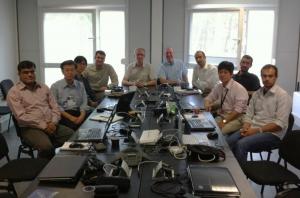Neutrons join generations
25 Oct 2010
-
Michael Loughlin, Nucl./Shield. Analysis and Coordinator
The neutron family (from left to right): Shrichand Jakhar (India), Hiro Iida (Japan), Mun-Seong Cheon (Korea), Raul Pampin (EU), Michael Loughlin (ITER), Russ Feder (US), Dieter Leichtle (EU), Masao Ishikawa (Japan), Jesus Izquierdo (EU), Eduard Polunovskiy (ITER). Taking part but not pictured Luciano Bertalot (ITER), Ulrich Fischer (EU), Alfred Hogenbirk (EU), Mahmoud Youssef (US); additional contributions from Zaixin Li (China) and the FDS Team (China).
The integrity of all components of ITER is demonstrated by a suite of complex computer simulations. All of these components will be subject to nuclear radiation of varying degrees and neutronics analyses is required to determine radiation exposure and response of all of these components.
The size and complexity of this task means it cannot be addressed by just one party but is an integral part of the design process which is carried out within the ITER Organization and amongst all Domestic Agencies. How do we ensure the consistency and quality of these analyses carried out by many teams?
This was the question which was addressed at a meeting involving several experts representing the ITER Organization, Japan, India, Europe, Korea and the US as well as associations from within Europe. The aim was to improve the techniques of analysis and after three days of discussion the result was an improved understanding of the specification of how neutronics analyses should be done and reported.
This outcome was the product of a collaboration between younger scientists and some of the most experienced analysts in the world working together. The younger scientists take back to their countries the benefits of training in advance technologies of radiation transport modelling from the experience of older heads, who in return get the energy, enterprise and innovation from newcomers. These are some of the early spin-offs from the world wide collaborative effort which is ITER. It was also an occasion when new friends were made and an optimistic view of the future was engendered.
Click here if you want to find out how to golf with a neutron ...


